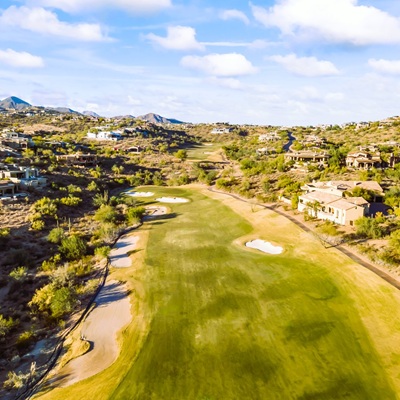What Golf Course Living Really Feels Like
Interest in homes backing right onto a golf course is understandable. The sunlit green views seem peaceful. But living there brings lots of lesser‑seen effects you should know about. From privacy concerns, noise, and wildlife visits to financial surprises, here’s the fuller picture of life in Greater Phoenix areas such as Scottsdale, Paradise Valley, Cave Creek, Chandler, and Gilbert.
Privacy Slip‑Throughs
Most golf course homes border open fairways. That means:
-
Your backyard, patio, or living room may be visible to passing golfers, carts, and maintenance crews
-
Chatting, lawn games, kids playing, and other family moments could be on display
-
Installing tall fences or dense hedges may be limited or banned by HOA rules
Coming home to a private space could feel like a challenge. You may have to invest in landscaping, creative screening, or even pay extra to align with HOA policies.
Golf Ball Damage
Beautiful green vistas come with hazards. Mis-hit balls can:
-
Shatter windows, dent vehicles, or damage roofs or siding
-
Ruin patio furniture, break pool liners, or hit decorative structures
-
Cause your insurance to go up, or you might not be covered
Even if your house sits near the green, it is not immune. Every wayward shot can have a cost that hits your bottom line.
Steady Noise Levels
Golf course homes often face daily noise. For example:
-
Lawn mowers, aerators, leaf blowers, and sprinkler systems start early in the morning
-
Maintenance workers stay active throughout the day
-
Conversations, laughter, and club slams from golfers provide constant ambient sound
If your home sits near tees or greens, expect more noise. And when the course hosts tournaments or corporate events, the buzz increases.
Also Read: 12 Must-Play Golf Courses Around Paradise Valley In Arizona
HOA Boundaries
Golf course communities usually are strict about how your home looks. This means:
-
You may need approval to change paint colors, install solar panels, or add patios, pools, or shade structures
-
Adding fences, large trees, or gardens could be off-limits or require sign‑off
-
HOA fees often pay for course upkeep, security, and shared spaces
That can drain your freedom. You might want to customize your property, but find yourself waiting for approvals or facing fines.
Chemicals & Drift
Keeping the golf course pristine involves regular spraying. What this can bring:
-
Herbicides, pesticides, and fertilizers can drift onto your lawn, outdoor seating, pool area, or garden
-
Those with allergies or respiratory issues may feel the effects
-
Long-term exposure could raise concerns for health and wellness
Even courses using reclaimed water or eco-friendly care can cause drift problems. It may affect kids, pets, or produce grown at home.
Financial Fluidity
Golf courses can change over time. Things to know:
-
A course in decline can lead to weaker green conditions and lower home values
-
A shift to public use, restructuring, or closure can leave you next to a field or new development
-
Resale may be harder, and faster value drops can happen if buyers shy away
Buying that view can feel good now, but might lose value or change shape over time.
Added Cost Burden
You might pay more for golf course access and upkeep. Consider:
-
Higher listing prices for homes with direct fairway access
-
Elevated property taxes tied to higher appraised values
-
HOA dues that cover course maintenance, shared spaces, and amenities
Adding it up over a lifetime of ownership could make a big difference compared to non-golf course homes.
Limited Personal Outdoor Space
Land often squeezes to accommodate greens. That often shows up as:
-
Narrow yards with little room for gardens, play areas, or outdoor kitchens
-
Landscape layouts carefully aligned with fairway lines, opposite private retreats
-
Roof lines, patios, and pool designs shaped by fairway proximity
If you want a lush backyard to lounge, grill, play, or garden, then a golf course lot might feel too small.
Wildlife Visits
Golf course greenery attracts animals. You may encounter:
-
Waterfowl like ducks or geese making themselves at home
-
Snakes, rabbits, raccoons, and other critters wandering through your yard
-
Droppings, noise, digging, and fences challenged by cheeky wildlife
Some people find this charming. Others feel it intrudes. Either way, it happens regularly and may need pest control or yard repairs.
Also Read: Important Things To Know When Buying An Arizona Golf Property
Nighttime Lights & Visual Clutter
Evenings can remain lit because:
-
Floodlights used for night games or events may shine into homes
-
Clubhouses and practice areas can glow well past sunset
-
Constant glare can affect sleep quality or evening quiet
If a dark sky and nighttime calm matter, then course lighting may feel intrusive.
Community & Tourism Swells
The privacy of golf course life can feel crowded during peak seasons. Expect:
-
Welcome centering around snowbirds and tournament attendees
-
Parking lots and restaurants filling up fast
-
Busy fairways, additional carts, and increased foot traffic
Public courses draw even bigger crowds compared to private venues. Private setups can ease that, but never remove it completely.
Recommendations For Savvy Buyers
If you still love the idea, consider this action list:
-
Review HOA rules in detail before buying
-
Ask insurance agents about golf course policy differences
-
Visit at dawn, midday, and dusk to check noise and activities
-
Ask current residents about wildlife, lighting, or visitors
-
Consider where the course may evolve or close over time
Final Word
A home on a golf course in Arizona can feel like a vacation every day. But it brings trade‑offs in privacy, noise, cost, insurance, yard space, wildlife, and uncertainty over time. If you understand and accept these trade‑offs, it can be a fantastic lifestyle. But don’t just lean in to views and curb appeal. Make sure you are comfortable with everything that comes with that pristine green backdrop.
